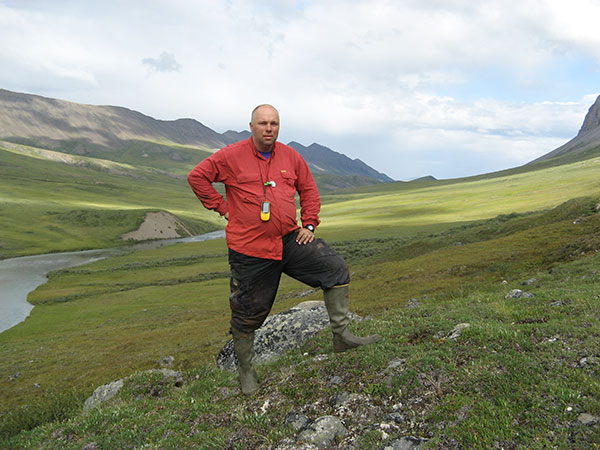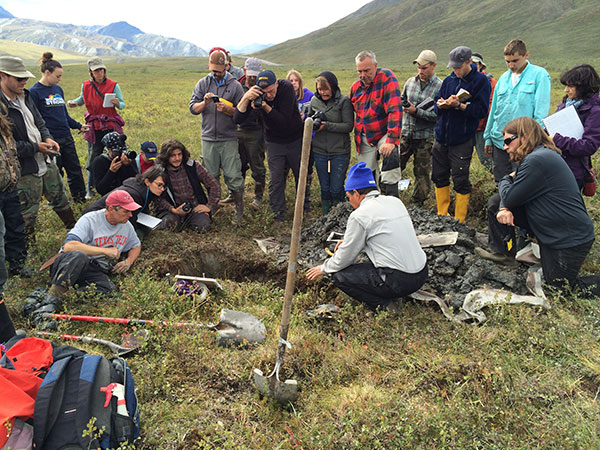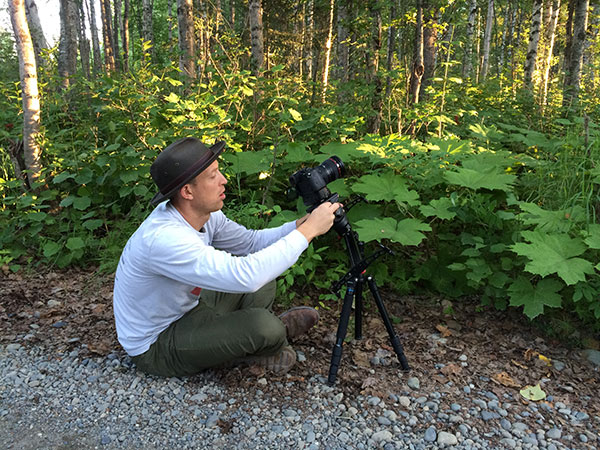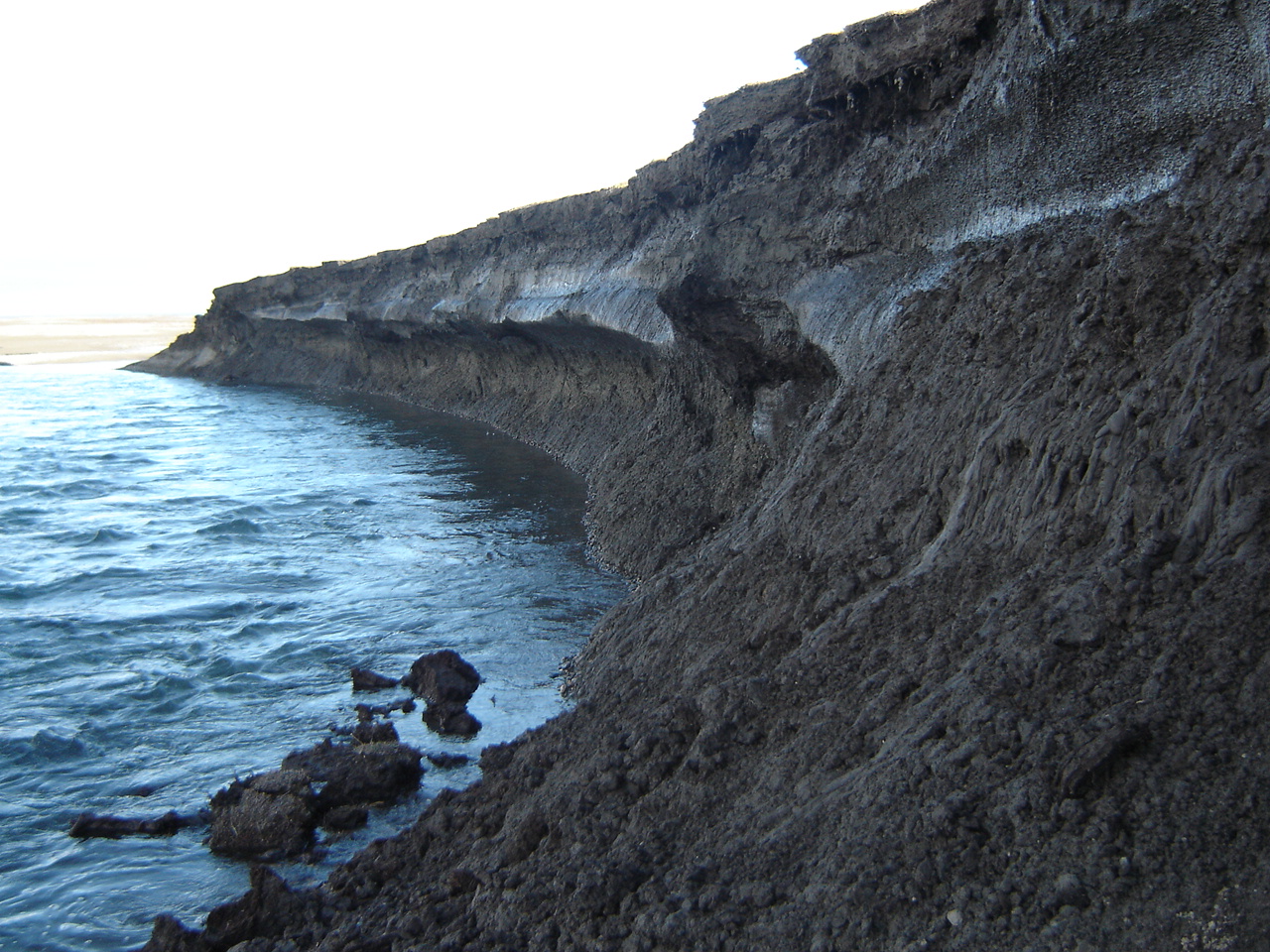Between Earth & Sky
By: Hannah Fields
Texas Tech Public Television general manager and soil science professor collaborate on documentary about climate change in Alaska.
With its beautiful exotic landscape, Alaska still remains an undiscovered destination to many Americans. While the awe-inspiring scenery is captivating, it's the Alaskan soil that tells a much broader story and two members of Texas Tech University have worked together to bring that story to life.

David C. Weindorf, professor, associate dean for research for the College of Agricultural Sciences and Natural Resources and BL Allen Endowed Chair of Pedology in the Department of Plant and Soil Science and Texas Tech Public Television General Manager Paul Allen Hunton joined forces to create the documentary "Between Earth and Sky—Climate Change on the Last Frontier".
The idea for "Between Earth and Sky" came from Weindorf's desire to honor University of Alaska Fairbanks professor Chien Lu Ping, who has been leading a renowned arctic soil field tour for the past 20 years. The tour, which began in interior Alaska in the eighties, soon expanded to southeastern Alaska and eventually into the permafrost regions. Through these tours, and his own research, Ping has helped to define the different features and variabilities of artic soils. Not only that, Ping has influenced and inspired young scientists to pursue research of arctic soil, teaching over 500 during his time conducting his artic soil field tour.
Weindorf began taking students on Ping's tour 10 years ago and was made a co-instructor after five years. After Ping announced his desire to retire in 2014, Weindorf was moved to capture Ping's last tour on film as a way to preserve Ping's dedication to arctic soils and the number of students and scientists in his field.
"I thought, for his last Arctic Soil Field Tour, wouldn't it be cool if we could somehow videotape it? I thought if we could videotape it, maybe we can get him to wear a microphone so we could really capture that audio. If we could do that, maybe we could get some lights out there. Before long, this idea of doing a documentary film was born," Weindorf said.
Soon after, Weindorf was introduced to Hunton to help get his idea off the ground. With their combined expertise, the two decided to add a climate change element to "Between Earth and Sky", not only to captivate audiences, but to explain the importance of the Alaskan arctic soil and how the changes being experienced in Alaska could soon move across the globe.

Previews of the documentary explain that these changes have caused Alaska to experience the largest regional warming of any US state, its temperature increasing by 3.4 degrees Fahrenheit since 1949. The warming trend has also caused much of Alaska's permafrost (permanently frozen ground), which holds 40% of the earth's carbon, to begin thawing. As the permafrost thaws, carbon contained therein is lost to the atmosphere. One form of carbon release is methane gas, which is liberated into the atmosphere as the permafrost thaws. Methane released into the atmosphere captures solar radiation, which adds to the warming of the climate, which, in turn, creates a repeating cycle of permafrost thaw and methane release.
"Arctic soils play such an important role in global climate dynamics because of the carbon that's stored in those soils—it's an incredible amount. So, with this triangle idea of having soils, climate change and arctic ecosystems we created the three pillars that hold up the stool and that's really how the project kind of developed," Weindorf said.
Arctic Filming and Storytelling
Filming of the project began in July of 2015, with the first trip taking place over the course of 21 days. A second crew from Alaska was hired to shoot the winter scenes because of schedule conflicts and, as Hunton admitted, was better suited for a crew more accustomed to the frigid climate. Then, it was on the last 10 to 11 days of shooting in April 2016 that Hunton and Weindorf returned for more personal stories.

"Like David was saying, we had that three pronged process of what we're telling the story about: arctic soils and how it affects climate and sort of that symbiotic relationship it has with ecosystems. We also needed to tell some personal stories because people are naturally connected as an audience, not just to the science, but also how it's affecting other human beings up there," Hunton said.
This desire to tell personal stories took the crew to the native village of Shishmaref, home of the Inupiaq people, where they spoke with native Alaskans about troubles they have been facing due to the change in climate. The small village, with an estimated population of 600 people, has been experiencing the loss of sea ice around their island. This loss of sea ice has exposed Shishmaref to a higher sea level and greater coastal storms. As the waves from these storms erode the island, pieces of it are pulled away, thus causing a shrinking effect.
For Shishmaref natives, who live primarily off the resources offered to them from the sea and land, losing their island means losing their way of life. The sea ice that once separated the village from the dangers of these storms is being lost, leaving much of the village left vulnerable to collapsing into the ocean. Worsening conditions are forcing the villagers to consider moving from the island, but that move would cost more than $200 million, a price tag that the village itself cannot afford.
Filming from this perspective put a needed personal angle along with the science which further backs up the importance of what scientists have been explaining in their climate research.
"The Shishmaref angle was really neat because it's not just the Alaska perspective, it's the native Alaskans. Having that kind of angle pulls a whole different perspective into things, which is really neat. One of the things we've talked about a lot is how we've interviewed all these great scientists. They're telling us from a scientific standpoint what's going on but then if you interview the common people, who are not scientists, they're telling you the same thing. It's amazing how that stuff is describing the same phenomenon in what they're seeing," Weindorf said.
With the combination of personal stories and commentary from renowned scientists such as Texas Tech's Katharine Hayhoe (who is acknowledged worldwide for her climate change expertise), Hunton and Weindorf were able to present how climate change goes beyond the Alaskan border.
"The film just isn't a personal story and it's not just scientific data. That mix of both really lends itself to make the film have a much more important impact on people because they're just not just seeing this personal story, they're also learning and understanding how what's happening in Shishmaref will eventually affect everybody on the globe and already is," Hunton said.
"When you see how the science is impacting real people's lives—the roads are buckling or they can't grow crops in these fields anymore—these are real things that are happening. It's not just theoretical, it's tangible. I think that's the key. From the onset of this project, we wanted this project to make sure it was factual and that it didn't come across as spin," Weindorf added.

Worldwide Debuts
Since completion of filming, "Between Earth and Sky" has already begun receiving positive feedback. After seeing clips from the documentary, U.S. Department of Agriculture Climate Science Center director Bill Hohenstein suggested clips be presented at the COP-22 international climate talks. This suggestion led Weindorf and Hunton to go through the state department and receive an invitation to present outtakes at the US Pavilion in Marrakesh, Morocco in November 2016.
Additional praise has come from the documentary's partners and funding sources, such as the USDA and Soil Science Society of America, with the president of the Soil Science Society of America calling the project both "cinematic" and "beautiful". Another source of positive praise has centered on the strong female voices within the documentary.
"We're really proud of showing strong female scientific voices. It's great for young women to see wanting to go into STEM fields and aspire to that. To see strong female scientists in a film like this will be a very positive thing," Hunton said.
The world premiere for "Between Earth and Sky" happened in March at the Wilson Center in Washington, D.C. as part of the Environmental Film Festival, which draws a crowd of 25,000 to 30,000 people each year. The documentary is also scheduled to be shown at more than a dozen universities such as Virginia Tech, Oregon State University and Utah State University.
Weindorf and Hunton will also be taking the documentary abroad, screening it at the European Geophysical Union's GeoCinema in Vienna, at Cambridge University (UK) and in Ancona, Italy. They also hope to have the documentary aired on streaming platforms such as Netflix, Hulu and iTunes.
Weindorf added that he thinks this project will be a timeless showpiece for Texas Tech with Hunton in agreement.
"The mantra of the university is 'bear our banners far and wide'. It doesn't mean we need to make Texas Tech products (foam fingers are great), but show that we're a product of Texas Tech. Meaning, Texas Tech invests in high quality people, researchers, scientists, faculty, and, then, what they do is a representation of what Texas Tech is. I feel with this film we've really done that. That's a testament to the administration as well as ourselves and our organization," Hunton said.
The Texas Tech premiere of "Between Earth and Sky" is scheduled for the fall of 2017.
Discoveries
-
Address
Texas Tech University, 2500 Broadway, Box 41075 Lubbock, TX 79409 -
Phone
806.742.3905 -
Email
vpr.communications@ttu.edu
